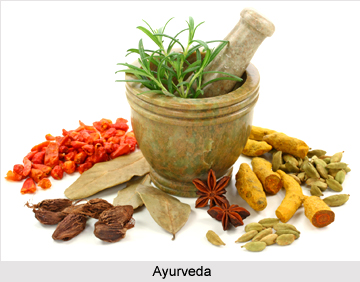 Traditional Indian medicine traces its roots to the Vedic period. The Vedas date back to almost five thousand years. It contains practical and scientific information on different subjects useful to the humanity like health, philosophy, engineering, astrology etc. Among the four Vedas, the Atharva Veda deals with health related topics. The Vedas discuss about various diseases and their treatment, medicinal herbs and their efficiency for removing the ailments. Both Charaka Samhita and Sushruta Samhita claim ayurveda to belong to Atharva Veda. Rig Veda also deals with many diseases, medicinal, herbs and fundamental principles of ayurveda. The essential principles of ayurvedic treatment based on tridosa viz. vata, pitta, and kapha can be traced from the Vedas. Besides this the seven basic elements of the body viz. rakta (blood), rasa (nourishing fluid of plasma), majja (bone-marrow), mamsa (flesh), meda (fat), asthi (bone) and sukra (semen) are also mentioned in the Vedas. Rig Veda places emphasis on proper food and diet for good health.
Traditional Indian medicine traces its roots to the Vedic period. The Vedas date back to almost five thousand years. It contains practical and scientific information on different subjects useful to the humanity like health, philosophy, engineering, astrology etc. Among the four Vedas, the Atharva Veda deals with health related topics. The Vedas discuss about various diseases and their treatment, medicinal herbs and their efficiency for removing the ailments. Both Charaka Samhita and Sushruta Samhita claim ayurveda to belong to Atharva Veda. Rig Veda also deals with many diseases, medicinal, herbs and fundamental principles of ayurveda. The essential principles of ayurvedic treatment based on tridosa viz. vata, pitta, and kapha can be traced from the Vedas. Besides this the seven basic elements of the body viz. rakta (blood), rasa (nourishing fluid of plasma), majja (bone-marrow), mamsa (flesh), meda (fat), asthi (bone) and sukra (semen) are also mentioned in the Vedas. Rig Veda places emphasis on proper food and diet for good health.
Traditional Indian Medicine in Vedas
The earliest literature on Indian medicine evolved during the Vedic period. The Rig Veda and the Atharva Veda mention in detail about the traditional Indian medicine. According to Rig Veda diseases mainly occur due to the imbalance of the three factors of the body called the `tri-dhatif, also known as tridosa. However, Atharva Veda states the same `tridosa-theory` in a somewhat different manner. According to Atharva Veda, diseases are caused by three elements viz. abhraja occurring due to moisture-ladden cloud which indicates excess of kapha element, vataja happening due to wind and susmaja indicating pitta or fiery element in the body.
Atharva Veda also discusses about the division of the vayu in the body as prana, apana, udana, vyana, and samana. Elementary human anatomy as well as blood circulation in the vessels has also been described in detail in the Atharva Veda. It also mentions about the various diseases of head, neck and liver, skin diseases, urinary diseases (prameha), and gynaecological and obstetrical diseases. The usage of different medicinal herbs has also been stated in Atharva Veda.
In the Vedic period people usually depended on treatment of diseases through application of medicinal herbs, water and other natural elements. Earlier Asrva (bleeding) was treated by pippali and munja grass application.
Four types of treatment mentioned in the Atharva Veda have been discussed below:
* Atharvana Chikitsa
* Angirasa Chikitsa
* Daivi Chikitsa
* Ausadhi Chikitsa
The Atharvana Chikitsa deals with the chanting of mantras. It is known as faith healing by way of psychiatry or psychotherapy or psychological type of treatment. The Angirasa Chikitsa discusses mainly about the medical treatment based on application of medicinal herbs and products of animals and birds. Daivi Chikitsa states about curing diseases with the help of natural elements such as sun rays, water, earth etc. It is a sort of naturopathy treatment where the elements of nature play the key role in healing diseases. Ausadhi Chikitsa is the curative treatment practised by application of finished products of medicines. Atharva Veda thus, deals with human anatomy, classification of diseases, herbal medicines and its application.
Besides the Vedas, the Brahmana literature also provides detailed information on traditional Indian medicines, the basic elements of the body, known as `dhatus`, the visible or the external body parts such as head, ear, nose, mouth, etc. and the unseen or internal body parts like heart, lung, spleen, kidney, vein or artery, liver, foetus, the inner membrane of the embryo etc. Different types of medicinal plants like aswagandha, khadira, apamarga, udumbara, bibhitaka, bilva etc., have also been described in the text.
The Sutra literature and the Upanishads have also provided with elaborate information about different body parts, their ailments, and cause of ailments, treatments and food habits. Kausika Sutra is another important text that provides important medical information. It deals with both the faith therapy and the medicinal therapy.
The traditional Indian medicine in the Vedic period thus, evolved significantly with the detailed study of the Vedas. People from different countries came to India to study about the ancient medicine and establish it in their own countries. Ayurvedic texts were also translated in Arabic language.




















